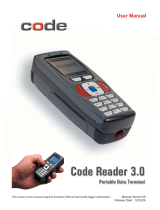
C004387_07_CR3500_User_Manual - iv
Save Settings
2.9 - Connuous Trigger Opmizaon Matrix ..............................................................................................33
2.10 - Connuous Scan ................................................................................................................................. 33
2.11 - Connuous Scan Sengs ..................................................................................................................34
2.11.1 - Connuous Scan - Sleep Time Out ...........................................................................................34
2.11.2 - Connuous Scan - Trigger Delays .............................................................................................34
2.11.3 - Connuous Scan - Duplicate Scan Suppression .......................................................................34
2.12 - Moon Detecon Scan Sengs ........................................................................................................34
Chapter 3 - CR3500 Programming: Symbology Sengs .............................................................................. 35
3.1 - Aztec Symbology...................................................................................................................................36
3.2 - Codabar Symbology ..............................................................................................................................36
3.3 - Codablock F Symbology ........................................................................................................................36
3.4 - Code 11 Symbology ..............................................................................................................................36
3.5 - Code 39 Symbology ..............................................................................................................................37
3.6 - Code 93 Symbology ..............................................................................................................................37
3.7 - Code 128 Symbology ............................................................................................................................37
3.8 - Composite Symbologies .......................................................................................................................38
3.9 - Data Matrix Symbology ........................................................................................................................38
3.10 - GoCode® Symbology ..........................................................................................................................38
3.11 - Interleaved 2 of 5 Symbology ............................................................................................................39
3.12 - Maxicode Symbology ..........................................................................................................................39
3.13 - Matrix 2 of 5 Symbology .....................................................................................................................39
3.14 - Micro PDF417 Symbology ...................................................................................................................39
3.15 - MSI Plessy Symbology ........................................................................................................................40
3.16 - NEC 2 of 5 Symbology .........................................................................................................................40
3.17 - Opcal Character Recognion (OCR) ..................................................................................................40
3.18 - PDF 417 Symbology ............................................................................................................................40
3.19 - Pharmacode .......................................................................................................................................41
3.20 - Postal Symbologies ............................................................................................................................. 41
3.21 - QR Code Symbology ...........................................................................................................................41
3.22 - GS1 Data Bar (formerly RSS) Symbology.............................................................................................42
3.23 - Telepen Symbology .............................................................................................................................42
3.24 - UPC/EAN/JAN .....................................................................................................................................42
Chapter 4 - Reader Feedback and Special Sengs ...................................................................................... 43
4.1 - Volume and Vibraon Sengs .............................................................................................................44
4.2 - Code Readability Index .........................................................................................................................44
4.3 - Backlight Intensity Sengs ...................................................................................................................45
4.4 - Backlight Timeout Sengs ...................................................................................................................45
4.5 - Targeng Sengs .................................................................................................................................45
4.6 - Reader Power O Sengs ....................................................................................................................45
4.7 - Reader ID and Firmware Version ..........................................................................................................46
4.8 - Reader Sengs Lock .............................................................................................................................46
4.9 - Time Stamp Sengs ........................................................................................................................... 47





















